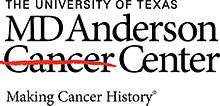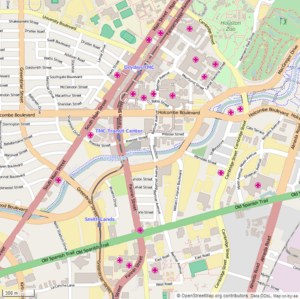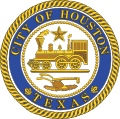University of Texas MD Anderson Cancer Center
| MD Anderson Cancer Center | |
|---|---|
 | |
   | |
| Geography | |
| Location | Houston, Texas, United States of America |
| Coordinates | 29°42′29″N 95°23′51″W / 29.707999°N 95.397525°WCoordinates: 29°42′29″N 95°23′51″W / 29.707999°N 95.397525°W |
| Organisation | |
| Care system | Public |
| Hospital type | Specialist |
| Affiliated university | University of Texas Health Science Center at Houston, Baylor College of Medicine, Texas A&M College of Medicine |
| Services | |
| Emergency department | Oncologic emergency center |
| Beds | 681 (as of 2018) |
| Speciality | Cancer |
| History | |
| Founded | 1941 |
| Links | |
| Website |
www |
The University of Texas MD Anderson Cancer Center (colloquially MD Anderson) is one of the original three comprehensive cancer centers in the United States. It is both a degree-granting academic institution, and a cancer treatment and research center located at the Texas Medical Center in Houston.
MD Anderson was created by an act of the Texas Legislature in 1941, making it a part of The University of Texas System and was established by the National Cancer Act of 1971.[1] Today it is one of 49 Comprehensive Cancer Centers designated by the National Cancer Institute. The cancer center provided care for about 127,000 patients in Fiscal Year 2014 and employs more than 20,000 people.[1]
It is affiliated with The University of Texas Health Science Center at Houston and Baylor College of Medicine. MD Anderson has an endowment of $486 million as of November 30, 2014.[2] In 2017, it has been ranked #1 for cancer care in USA by the U.S. News and World Report.[3]
History
The cancer center is named after Monroe Dunaway Anderson, a banker and cotton trader from Jackson, Tennessee. He was a member of a business partnership with his brother-in-law Will Clayton. Their company became the largest cotton company in the world. Anderson feared that in the event of one of the partners' deaths, the company would lose a large amount of money to estate tax and be forced to dissolve. To avoid this, Anderson created the MD Anderson Foundation with an initial sum of $300,000. In 1939 after Anderson's death, the foundation received $19 million.
In 1941 the Texas Legislature had appropriated $500,000 to build a cancer hospital and research center. The Anderson Foundation agreed to match funds with the state if the hospital were located in Houston in the Texas Medical Center (another project of the Anderson Foundation) and named after Anderson.[4]
Using surplus World War II Army barracks, the hospital operated for 10 years from a converted residence and 46 beds leased in a Houston hospital before moving to its current location in 1954.[4]
The institution became the subject of controversy in 2005, when it leased the use of its name to private investors who intended to promote a particular therapeutic approach, proton therapy. An article in the Houston Chronicle suggested that the arrangement between the Center and the investors might skew incentives, providing M.D. Anderson with non-medical reasons to "send as many patients as possible into the program."[5]
Organization
Mission
MD Anderson is focused on research on causes, treatments, and prevention of cancer, with the stated mission of "Making Cancer History." In FY 2014, about 8,000 patients participated in therapeutic clinical research exploring novel treatments, making it the largest program of its kind in the United States.[1]
Status
Being part of The University of Texas System, MD Anderson Cancer Center is managed under a nonprofit structure; however, for-profit agreements[6][7] have caused some to question the motives of the center.[8][9][10][11]
MD Anderson enjoys university status by providing fellowship, internship and residency opportunities to Ph.D.s and medical professionals. The institution offers master's degrees and Ph.D.s to students enrolled in The University of Texas Graduate School of Biomedical Sciences, which it operates with UT Health Science Center at Houston. Areas of study include: immunology, cancer biology, genes and development, molecular carcinogenesis, medical physics, biomathematics and biostatistics, experimental therapeutics, and virology and gene therapy. Through its School of Health Professions, the cancer center also offers bachelor's degrees in nine allied health fields, including clinical laboratory science, cytogenetic technology, cytotechnology, diagnostic imaging, histotechnology, medical dosimetry, molecular genetic technology and radiation therapy. The school also offers a master of science in diagnostic genetics program.
Recognition
In addition to its No. 1 ranking in cancer care by U.S. News & World Report, the cancer center ranks first in the number of National Cancer Institute grants and invested more than $735 million in research in FY 2014. The cancer center also has received Magnet Nursing recognition[12] from the American Nurses Credentialing Center.
In May 1996, the Pan American Health Organization (PAHO/WHO) established the Collaborating Center for Supportive Cancer Care at the Pain Research Group, The University of Texas M. D. Anderson Cancer Center.[13] The terms of reference engage the Anderson Center in the development of palliative care programs throughout Latin America and the Caribbean.[14]
Presidents
MD Anderson has had five full-time presidents in its history:
- R. Lee Clark, M.D. (1946–1978)
- Charles LeMaistre, M.D. (1978–1996)
- John Mendelsohn, M.D. (1996–2011)
- Ronald DePinho, M.D. (2011–2017)
- Peter WT Pisters, M.D. (2017–present)[15]
Mendelsohn stepped down from his position on Sept. 1, 2011, when Ronald A. DePinho, M.D., became president.[16] Mendelsohn remains on the faculty as co-director of the new Sheikh Khalifa Bin Zayed Al Nahyan Institute for Personalized Cancer Therapy.
Growth
United States growth
The cancer center continues to grow, increasing in size by 50% in the past 10 years. The complex now includes more than 600 inpatient beds, several research buildings and outpatient clinic buildings, two faculty office buildings, and a patient-family hotel in addition to other off-site facilities for clinical and research use.
Recently completed construction projects include two new research buildings on MD Anderson's South Campus and the addition of nine floors that can accommodate more than 300 new inpatient beds in Alkek Hospital on the North Campus.[17]
MD Anderson's first facility on its Mid Campus opened in 2011, and includes a 25-story building to support current office space and future growth needs.
Also in 2011 the Khalifa Bin Zayed Al Nahyan Foundation gave $150 million to MD Anderson.[18] The new Sheikh Khalifa Bin Zayed Al Nahyan Building for Personalized Cancer Care is an international center of clinical excellence focusing on using the latest advances in genetic information to develop safe, more effective treatments for patients on a case-by-case basis.
In 2012 the Houston Main Building (originally the Prudential Building) was demolished, with plans to redevelop the site. The building had originally been purchased by MD Anderson in 1974 for $18.5 million.[19][20]
International growth
In 2000 MD Anderson officials inaugurated MD Anderson International-España, its first international affiliation and Spain's first multidisciplinary full-service cancer center. Located in Madrid, the center offers access to many of the clinical trials offered at MD Anderson.
MD Anderson Cancer Center Madrid is a venture between MDA Holding Spain, S.A., a Spanish investment consortium, and the MD Anderson Outreach Corporation, a health care organization created in 1989 to open and expand access to MD Anderson's internationally recognized standard of cancer care. Funding was provided by participants in Madrid.[21]
In return for assisting with the development and operation of the Madrid facility, MD Anderson Outreach Corporation has a small equity and share in profits. Neither MD Anderson Cancer Center nor MD Anderson Outreach Corporation has invested any actual dollars in the project.
MD Anderson Outreach Corporation has two seats on the 11-member board of directors of MDA Holding Company. The two board seats have significant "reserve powers," which mandate that both representatives approve certain decisions such as those related to quality assurance.
Locations

Texas Medical Center
MD Anderson Cancer Center is located at the Texas Medical Center in Houston.[22] The Texas Medical Center is the largest medical center in the world with one of the highest densities of clinical facilities for patient care, basic science, and translational research.
The MD Anderson campus is divided into the North Campus, Mid Campus and South Campus.[23] The North Campus includes: The Main Building, which comprises Alkek Hospital,[17] Bates-Freeman Building, Clark Clinic, Gimbel Building, Jones Research Building, LeMaistre Clinic, Love Clinic and Lutheran Hospital Pavilion. Other facilities on this campus are the Dan L. Duncan Building, Clinical Research Building, Faculty Center, Mays Clinic, Mitchell Basic Sciences Research Building, Pickens Academic Tower, Radiology Outpatient Center and Rotary House International. The T. Boone Pickens Academic Tower, a 21-story, 730,000-square-foot (68,000 m2) building, which opened in 2008, is named after T. Boone Pickens, who donated to the cancer center. It houses classrooms, conference facilities, and executive and faculty offices.[24]
The South Campus is home to the McCombs Institute for the Early Detection and Treatment of Cancer,[25] which includes seven translational research centers focused on genomics, proteomics, screening, diagnostic imaging and drug development.
The Mid Campus building, a 25-story building to support current office space and future growth needs, opened in 2011.
Other locations
MD Anderson operates several other locations within the Houston area. They include:
- MD Anderson League City, on the University of Texas Medical Branch League City campus[26]
- MD Anderson in Sugar Land:, on the campus of St. Luke's Sugar Land Hospital[27]
- MD Anderson in The Woodlands, on the campus of St. Luke's The Woodlands Hospital[29]
- MD Anderson Surgical Clinic in Memorial City, on the campus of Memorial Hermann Memorial City Medical Center[30]
- MD Anderson Gynecologic Oncology Clinic in the Texas Medical Center, on the campus of The Woman's Hospital of Texas[31]
In September 2018, in collaboration with The University of Texas Medical Branch, the MD Anderson Bay Area location moved to a newly-built facility in League City, Texas.[32]
MD Anderson also has operations outside of Texas. The MD Anderson Radiation Treatment Center at Presbyterian Kaseman Hospital is located in the Presbyterian Kaseman Hospital in Albuquerque, New Mexico.[33] Banner MD Anderson Cancer Center in Gilbert, a city in the Greater Phoenix area of Arizona, opened in September 2011.[34] MD Anderson Cancer Center at Cooper, located in Camden, New Jersey, opened in October 2013. Baptist MD Anderson Cancer Center in Jacksonville, Florida, opened in October 2015.[35]
In addition, the MD Anderson Radiation Treatment Center in Istanbul at American Hospital is located in the Vehbi Koc Foundation (VKF) American Hospital in Istanbul, Turkey.[36]
Sister institutions
MD Anderson has formed sister institution relationships with more than 25 organizations in Asia, Europe, Central America and South America through its Global Academic Programs department. Collaborations focus on research, prevention, education and patient care.[37]
MD Anderson Services Corporation
MD Anderson Services Corporation[38] (formerly MD Anderson Cancer Center Outreach Corporation[39]) was established in 1989 as a not-for-profit corporation to enhance revenues of The University of Texas MD Anderson Cancer Center by establishing joint ventures in selected markets, providing additional referrals to the institution, contracting for delivery of inpatient and out-patient management, using existing UT MD Anderson Cancer Center reference laboratory services, and fostering additional philanthropy in distant areas.
See also
References
- 1 2 3 "Institutional Profile". M. D. Anderson Cancer Center. Archived from the original on March 3, 2009. Retrieved March 20, 2009.
- ↑ "Endowment Information". www.utimco.org.
- ↑ "US News and World Report 2017 Cancer Center Rankings". Archived from the original on 2010-04-15.
- 1 2 "Who was M. D. Anderson? - M. D. Anderson Cancer Center". Archived from the original on March 3, 2009. Retrieved March 20, 2009.
- ↑ Feldstein, Dan. "M.D. Anderson private venture raises questions Proton-therapy benefits at center won't merit costs of care, some say." Houston Chronicle. Retrieved on January 20, 2011.
- ↑ "Archived copy". Archived from the original on 2006-08-27. Retrieved 2006-08-25.
- ↑ Feldstein, Dan (2005-11-23). "MD Anderson private venture raises questions: Proton-therapy benefits at center won't merit costs of care, some say". The Houston Chronicle. Archived from the original on 2009-09-15. Retrieved 2009-04-16.
- ↑ Md, Roy M. Poses (28 October 2005). "Health Care Renewal: M. D. Anderson Cancer Center Leases Its Name".
- ↑ "Archived copy". Archived from the original on 2009-09-21. Retrieved 2006-08-25.
- ↑ Rubenstein, Sarah (April 28, 2008). "Hospitals to Patients: Pay Us Now, or We Won't Treat You". The Wall Street Journal.
- ↑ Martinez, Barbara (April 28, 2008). "Cash Before Chemo: Hospitals Get Tough". The Wall Street Journal.
- ↑ "Magnet Facilities: Health Care Organizations with Magnet-Designated Nursing Services". American Nurses Credentialing Center. July 7, 2006. Archived from the original on February 13, 2008. Retrieved October 15, 2007.
- ↑ About the Collaborating Center. http://www3.mdanderson.org/depts/prg/aboutcc.htm
- ↑ De Lima L1, Bruera E.The Pan American Health Organization: its structure and role in the development of a palliative care program for Latin America and the Caribbean.J Symptom Manage 2000 Dec;20(6):440-8.
- ↑ "Peter WT Pisters, M.D., begins tenure as president of MD Anderson". M. D. Anderson Cancer Center. Retrieved December 1, 2017.
- ↑ "Ronald A. DePinho, M.D." The University of Texas System. Archived from the original on June 22, 2011. Retrieved June 9, 2011.
- 1 2 "MD Anderson to Expand 12-Story Alkek Hospital Archived 2011-06-10 at the Wayback Machine."
- ↑ Ackerman, Todd. "M.D. Anderson receives $150 million gift." Houston Chronicle. January 18, 2011. Retrieved on January 20, 2011.
- ↑ Hoover, Kent. "Preservationists oppose plan to demolish historic building." Houston Business Journal. Friday March 29, 2002. Retrieved on April 4, 2010.
- ↑ Bell, Jim. "The Art Problem at M.D. Anderson." KUHF. April 22, 2008. Retrieved on April 4, 2010.
- ↑ Penne, Julie (July 15, 2000). "MD Anderson Cancer Center Unveils New Facility in Spain". Texas Medical Center NEWS. Archived from the original on February 11, 2008. Retrieved October 15, 2007.
- ↑ "Locations." University of Texas M. D. Anderson Cancer Center. Retrieved on April 4, 2010.
- ↑ "New Construction." University of Texas M. D. Anderson Cancer Center. December 20, 2005. Retrieved on April 4, 2010.
- ↑ DeStefano, DeDe. "$50 Million Gift Sets Record for M. D. Anderson Archived 2011-06-10 at the Wayback Machine.." Conquest at University of Texas M. D. Anderson Cancer Center. Summer (northern hemisphere) 2007. Retrieved on April 4, 2010.
- ↑ "McCombs Institute"
- ↑ "MD Anderson League City". MD Anderson Cancer Center.
- ↑ "MD Anderson / St. Luke's Sugar Land Hospital". MD Anderson Cancer Center.
- ↑ "MD Anderson / Christus S. Catherine Hospital". MD Anderson Cancer Center.
- ↑ "MD Anderson / St. Luke's The Woodlands Hospital". MD Anderson Cancer Center.
- ↑ "MD Anderson / Memorial Hermann Memorial City Medical Center". MD Anderson Cancer Center.
- ↑ "MD Anderson / The Woman's Hospital of Texas". MD Anderson Cancer Center.
- ↑ "UTMB, MD Anderson to collaborate on League City campus". MD Anderson Cancer Center.
- ↑ "MD Anderson Cancer Center Radiation Treatment Center at Presbyterian Kaseman Hospital Archived 2010-03-05 at the Wayback Machine.." Presbyterian Kaseman Hospital. Retrieved on April 4, 2010.
- ↑ "MD Anderson Banner Cancer Center Archived 2010-02-13 at the Wayback Machine.." Banner Health. Retrieved on April 4, 2010.
- ↑ "Our Locations". MD Anderson Cancer Center.
- ↑ Cancerwise Blogger. "M. D. Anderson in Istanbul, Turkey." University of Texas MD Anderson Cancer Center. February 2, 2010. Retrieved on April 4, 2010.
- ↑ "Global Academic Programs ."
- ↑ "TABLE OF CONTENTS FOR HEALTH AFFAIRS COMMITTEE: Committee Meeting: 2/3/2004" (PDF). The University of Texas System. February 3, 2004. Archived from the original (PDF) on October 26, 2007. Retrieved October 15, 2007.
- ↑ "HEALTH AFFAIRS COMMITTEE: Committee Chairman Oxford". The University of Texas System. August 9, 2001. Archived from the original (DOC) on October 26, 2007. Retrieved October 15, 2007.
External links
| Wikimedia Commons has media related to The University of Texas M. D. Anderson Cancer Center. |
